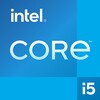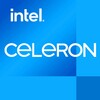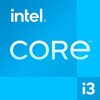Intel Core i5-1140G7 vs Intel Celeron 7300 vs Intel Core i3-1210U
Intel Core i5-1140G7
► remove from comparison
The Intel Core i5-1140G7 is a power-efficient quad-core SoC for laptops and Ultrabooks based on the Tiger Lake-U generation (UP4) that was introduced in early 2021. It integrates four Willow Cove processor cores (8 threads thanks to Hyper-Threading). The guaranteed base clock speed depends on the TDP setting and can range from 0.8 (7 W TDP) to 1.8 GHz (15 W TDP). The Turbo clock speed is specified at 4.2 GHz for one core, all cores can reach up to 3.5 GHz.
Another novelty is the integrated Xe graphics card with 80EUs based on the completely new Gen 12 architecture. It offers a significantly higher performance compared to the older Iris Plus G7 (Ice Lake). In the i5-1140G7 it uses 80 of the 96 EUs and clocks between 400 - 1100 MHz. The GPU and CPU can together use the 8 MB of L3 cache.
Furthermore, Tiger Lake SoCs add PCIe 4 support (four lanes), AI hardware acceleration, and the partial integration of Thunderbolt 4 / USB 4 and Wi-Fi 6 in the chip. The i5-1140G7 also supports the management feature vPro.
Performance
The average 1140G7 in our database is in the same league as the N95 and also the Pentium 7505, as far as multi-thread benchmark scores are concerned. This is a pretty poor result, as of early 2023.
Your mileage may vary depending on how high the CPU power limits are, and how competent the cooling solution of your system is.
Power consumption
This Core i5 has a default TDP of 7 W to 15 W, the expectation being that laptop manufacturers will go for a higher value in exchange for higher performance. Those values are rather low, meaning at least a few passively cooled designs are to be expected.
Core i5-1140G7 is manufactured on Intel's 2nd generation 10 nm process marketed as SuperFin for decent, as of early 2023, energy efficiency.
Intel Celeron 7300
► remove from comparison
The Intel Celeron 7300 is an entry-level mobile CPU for thin and light laptops based on the Alder Lake architecture. It was announced in early 2022 and offers one performance core (P-cores, Golden Cove architecture) and 4 efficient cores (E-cores, Gracemont architecture). The CPU does not support HyperThreading leading to only 5 supported threads at once. The clock rate of the performance cluster is 1000 MHz, the one of the efficient cluster is 700 MHz. The performance of the E-cores should be similar to old Skylake cores (compare to the Core i7-6700HQ). All cores can use up to 8 MB L3-cache. Compared to the faster Core i3-1215U, the Celeron offers one less P-core and lower clock speeds (no Turbo).
Performance
Thanks to the 5 cores, the multi-threaded performance should be clearly faster than the older dual-core Tiger Lake CPUs with 15 Watt (like the Intel Core i3-1115G4). However, due to the missing Turbo and the low clock speed, the single core performance will be very low.
Features
The integrated memory controller supports various memory types up to DDR5-4800, DDR4-3200, LPDDR5-5200, and LPDDR4x-4267. The Thread Director (in hardware) can support the operating system to decide which thread to use on the performance or efficient cores for the best performance. For AI tasks, the CPU also integrates GNA 3.0 and DL Boost (via AVX2). Quick Sync in version 8 is the same as in the Rocket Lake CPUs and supports MPEG-2, AVC, VC-1 decode, JPEG, VP8 decode, VP9, HEVC, and AV1 decode in hardware. The CPU only supports PCIe 4.0 (14 lanes combined with Gen 3).
The integrated graphics card is based on the Xe-architecture and offers 48 of the 96 EUs (Execution Units) operating at up to 0.8 GHz.
The CPU is rated at 15 W base power (TDP, PL1) and 55 W max. power (PL2). The minimum assured power is 12 Watt. The whole SoC is manufactured in a 10nm process at Intel, which is known as Intel 7.
Intel Core i3-1210U
► remove from comparison
The Intel Core i3-1210U is a low power mobile CPU for thin and light laptops based on the Alder Lake architecture. It was announced in early 2022 and offers 2 performance cores (P-cores, Golden Cove architecture) and 4 efficient cores (E-cores, Gracemont architecture). The P-cores support Hyper-Threading leading to 8 supported threads when combined with the E-cores. The clock rate ranges from 1 to 4.4 GHz on the performance cluster and 0.7 to 3.3 GHz on the efficient cluster. The performance of the E-cores should be similar to old Skylake cores (compare to the Core i7-6700HQ). All cores can use up to 10 MB L3 cache.
Performance
While we have not tested a single system built around the 1210U as of August 2023, we fully expect its multi-thread performance to be pretty much identical to that of the i3-1215U. Which is pretty fast for an entry-level chip, as of mid 2023.
Your mileage may vary depending on how high the CPU power limits are and how competent the cooling solution of your system is.
Features
The integrated memory controller supports various memory types up to DDR5-4800, DDR4-3200, LPDDR5-5200, and LPDDR4x-4267. The Thread Director (in hardware) can support the operating system to decide which thread to use on the performance or efficient cores for the best performance. For AI tasks, the CPU also integrates GNA 3.0 and DL Boost (via AVX2). Quick Sync in version 8 is the same as in the Rocket Lake CPUs and supports MPEG-2, AVC, VC-1 decode, JPEG, VP8 decode, VP9, HEVC, and AV1 decode in hardware. The CPU only supports PCIe 4.0 (x8 for a GPU and two x4 for SSDs).
The integrated graphics adapter is based on the Xe-architecture and offers 64 of the 96 EUs (Execution Units) operating at up to 0.9 GHz.
Power consumption
This Core i3 has a Base power consumption of 9 W, with 29 W being its maximum Intel-recommended Turbo power consumption. TDP values that low allow for passively designs as long as performance is not a priority.
The CPU is built with Intel's 3rd generation 10 nm process marketed as Intel 7 for decent, as of early 2023, energy efficiency.
| Model | Intel Core i5-1140G7 | Intel Celeron 7300 | Intel Core i3-1210U | ||||||||||||||||||||||||||||||||||||||||||||||||||||||||||||||||||||||||||||||||||||||||||||||||||||||||||||||||||||||||||||||||||||||||
| Codename | Tiger Lake-UP4 | Alder Lake-U | Alder Lake-U | ||||||||||||||||||||||||||||||||||||||||||||||||||||||||||||||||||||||||||||||||||||||||||||||||||||||||||||||||||||||||||||||||||||||||
| Series | Intel Tiger Lake | Intel Alder Lake-M | Intel Alder Lake-M | ||||||||||||||||||||||||||||||||||||||||||||||||||||||||||||||||||||||||||||||||||||||||||||||||||||||||||||||||||||||||||||||||||||||||
| Series: Alder Lake-M Alder Lake-U |
|
|
| ||||||||||||||||||||||||||||||||||||||||||||||||||||||||||||||||||||||||||||||||||||||||||||||||||||||||||||||||||||||||||||||||||||||||
| Clock | 1800 - 4200 MHz | 700 - 1000 MHz | 700 - 4400 MHz | ||||||||||||||||||||||||||||||||||||||||||||||||||||||||||||||||||||||||||||||||||||||||||||||||||||||||||||||||||||||||||||||||||||||||
| L1 Cache | 320 KB | 464 KB | 544 KB | ||||||||||||||||||||||||||||||||||||||||||||||||||||||||||||||||||||||||||||||||||||||||||||||||||||||||||||||||||||||||||||||||||||||||
| L2 Cache | 5 MB | 3.5 MB | 5 MB | ||||||||||||||||||||||||||||||||||||||||||||||||||||||||||||||||||||||||||||||||||||||||||||||||||||||||||||||||||||||||||||||||||||||||
| L3 Cache | 8 MB | 8 MB | 10 MB | ||||||||||||||||||||||||||||||||||||||||||||||||||||||||||||||||||||||||||||||||||||||||||||||||||||||||||||||||||||||||||||||||||||||||
| Cores / Threads | 4 / 8 | 5 / 5 1 x 1.0 GHz Intel Golden Cove P-Core 4 x 0.7 GHz Intel Crestmont E-Core | 6 / 8 | ||||||||||||||||||||||||||||||||||||||||||||||||||||||||||||||||||||||||||||||||||||||||||||||||||||||||||||||||||||||||||||||||||||||||
| TDP | 15 Watt | 9 Watt | 9 Watt | ||||||||||||||||||||||||||||||||||||||||||||||||||||||||||||||||||||||||||||||||||||||||||||||||||||||||||||||||||||||||||||||||||||||||
| Technology | 10 nm | 10 nm | 10 nm | ||||||||||||||||||||||||||||||||||||||||||||||||||||||||||||||||||||||||||||||||||||||||||||||||||||||||||||||||||||||||||||||||||||||||
| max. Temp. | 100 °C | 100 °C | 100 °C | ||||||||||||||||||||||||||||||||||||||||||||||||||||||||||||||||||||||||||||||||||||||||||||||||||||||||||||||||||||||||||||||||||||||||
| Socket | BGA1598 | BGA1700 | BGA1744 | ||||||||||||||||||||||||||||||||||||||||||||||||||||||||||||||||||||||||||||||||||||||||||||||||||||||||||||||||||||||||||||||||||||||||
| Features | LPDDR4x-4266 RAM, PCIe 4, 2 GT/s bus, DL Boost, GNA, vPro, MMX, SSE, SSE2, SSE3, SSSE3, SSE4.1, SSE4.2, AVX, AVX2, AVX-512, BMI2, AMB, FMA, ADX, SMX, SMEP, SMAP, EIST, TM1, TM2, HT, Turbo, SST, AES-NI, RDRAND, RDSEED, SHA, TME | Thread Director | LPDDR4x-4266/LPDDR5-5200 RAM, PCIe 4, Thr. Director, DL Boost, GNA, MMX, SSE, SSE2, SSE3, SSSE3, SSE4.1, SSE4.2, AES, AVX, AVX2, FMA3, SHA | ||||||||||||||||||||||||||||||||||||||||||||||||||||||||||||||||||||||||||||||||||||||||||||||||||||||||||||||||||||||||||||||||||||||||
| iGPU | Intel Iris Xe Graphics G7 80EUs (400 - 1100 MHz) | Intel UHD Graphics Xe G4 48EUs ( - 800 MHz) | Intel UHD Graphics 64EUs (Alder Lake 12th Gen) ( - 850 MHz) | ||||||||||||||||||||||||||||||||||||||||||||||||||||||||||||||||||||||||||||||||||||||||||||||||||||||||||||||||||||||||||||||||||||||||
| Architecture | x86 | x86 | x86 | ||||||||||||||||||||||||||||||||||||||||||||||||||||||||||||||||||||||||||||||||||||||||||||||||||||||||||||||||||||||||||||||||||||||||
| Announced | |||||||||||||||||||||||||||||||||||||||||||||||||||||||||||||||||||||||||||||||||||||||||||||||||||||||||||||||||||||||||||||||||||||||||||
| Manufacturer | ark.intel.com | ark.intel.com | ark.intel.com |
Benchmarks
Average Benchmarks Intel Core i5-1140G7 → 0% n=0
* Smaller numbers mean a higher performance
1 This benchmark is not used for the average calculation












